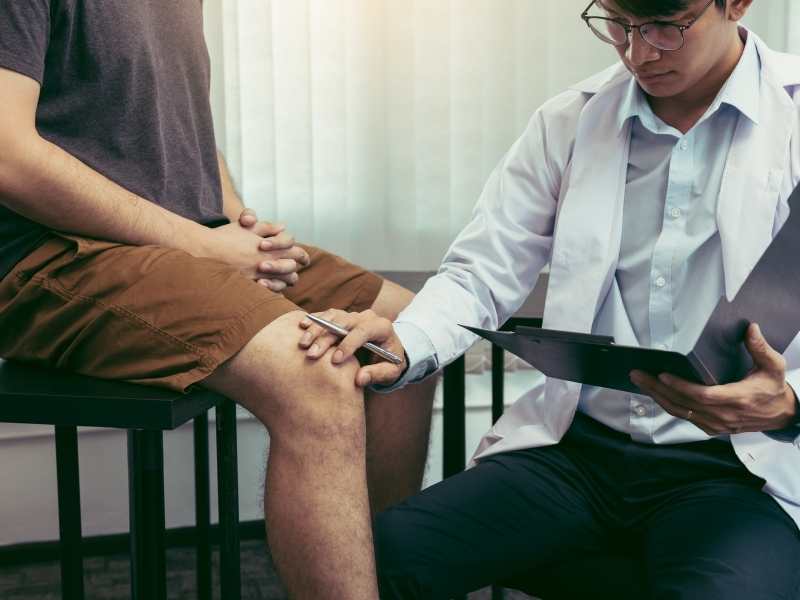[vc_row][vc_column][vc_column_text]
What is hypogonadism?
Hypogonadism occurs when the sex glands and their hormones, such as testosterone or estrogen are not producing enough of them. It can affect both males/males AND females/females; but there’ certain types that only apply to one gender (eunuch). The condition causes an absence in libido which leads people feeling depressed sometimes because they lack desire for any form sexual activity whatsoever.
Male Hypogonadism
Male hypogonadism is a disorder in which the body does not create enough testosterone, a hormone critical for manly growth and development throughout puberty, or sperm, or both. Male hypogonadism can be congenital or develop later in life, frequently as a result of injury or infection
What are the causes of Hypogonadism and the methods used for diagnosis?
Hypogonadism is a condition that affects how much testosterone someone has in their body. People with hypogonadism don’t make enough of this hormone, which can cause symptoms like low energy and mood swings, irritability[AB1] .When talking about diagnosis there are three common methods used today to diagnose. The blood tests is utilized to check levels of sex, thyroid and pituitary hormones. The imaging techniques such as MRI or CT scans done by technicians who knows what they’re looking for because sometimes these conditions have already caused damage before showing up on an examination table.
Signs and Symptoms of Low Testosterone
After the age of 40, many men up to 40% experience low serum testosterone, often known as hypogonadism or andropause. As you age, your risk of low testosterone increases.
You may have low testosterone if you exhibit the following symptoms:
- Erectile dysfunction
- Low libido
- Reduced sexual activity
- Increased body fat
- Low energy and weariness
- Depression
Factors that contribute to low testosterone
- Hypertension
- Hypercholesterolemia
- Obesity
- Opioid abuse
- Diabetes
Hormone Replacement Therapy for Testosterone (TRT)
Your doctor can assist you in increasing your testosterone levels with replacement therapy. This therapy involves the administration of testosterone via gels, tablets, patches, or injections.
Blood Tests and PSA Testing
Your doctor will draw blood to determine your testosterone levels. They will also examine for other hormones that may contribute to low testosterone, such as estradiol and luteinizing hormone.
Additionally, your doctor will conduct a blood test to determine your PSA levels. Increased PSA levels may indicate prostate cancer, which can have an effect on testosterone levels’ most men age, low testosterone becomes a leading health concern. Although testosterone levels generally decline with age, getting older isn’t the only factor that can result in low testosterone. Suspect you are experiencing low testosterone levels? The experts at HealthyMe Medical Therapies in Miami Shores, Florida, can determine if there’s an underlying cause and offer treatments such as hormone replacement therapy. Schedule an appointment online or by phone today for help with low testosterone if you’re in the greater Miami or Fort Lauderdale areas of South Florida.
What is The Definition of Testosterone?
Testosterone is the primary male sex hormone that helps regulate a number of the body’s processes, including fertility, sex drive, muscle mass, fat distribution, and red blood cell production. Although testosterone is known as the male sex hormone, it’s also present in small amounts in women. In women, testosterone is responsible for sex drive, bone density, and muscle strength.
What causes low testosterone?
Testosterone levels can drop for a number of reasons. Because men produce testosterone in the testes, any damage to the testes can cause low levels of testosterone. Chronic conditions that affect the body’s hormone balance can also result in abnormal testosterone levels.
Some of the most common causes of low testosterone include:
- Injury or infection in the testicles
- Medications
- Hormone disorders
- Type 2 diabetes
- Kidney disease
- Liver disease
- Obesity
- HIV/AIDS
Testosterone levels also gradually drop with age. Although low levels of testosterone can be diagnosed as hypogonadism, most cases of age-induced low hormone levels can be attributed to the normal effects of aging. For most men over 50, having lower levels of testosterone is perfectly normal, but treatments are available to boost testosterone levels.
Symptoms of low testosterone?
Some of the symptoms of low testosterone include:
- Erectile dysfunction (ED)
- Decreased facial and body hair
- Decreased muscle mass
- Loss of bone mass
- Development of breast tissue
Because low testosterone levels can make it difficult to lead a normal life, it’s important that you discuss your symptoms with an experienced physician. At the Urology Specialist Group, the team has over 30 years of combined experience helping men address their sexual and reproductive health concerns.
Treatment of Low Testosterone
The first step in treating your low testosterone levels is to diagnose the cause of your hormonal imbalance. Your urologist can measure your testosterone levels using a blood test. If your low testosterone is caused by an underlying condition such as diabetes or an injury to your testes, then the best option is to treat that condition first.
To help increase your testosterone levels, there are treatment options such as testosterone replacement therapy that help replace and regulate hormone levels. Testosterone replacement therapy can be administered in the form of injections, topical gels, patches, and pellets.
Testosterone deficiency does not have one single symptom, and it’s challenging to definitively diagnose a man as suffering from low testosterone unless he visits his medical provider and is diagnosed as such. Men who suffer one or more of the following symptoms may be suffering from low testosterone:
- Decreased sex drive. Probably the foremost symptom of low testosterone is a decrease in a man’s sex drive. A man who finds his sex drive dropping—whether suddenly or over a lengthy period of time—should talk to his doctor, particularly if he is over the age of 35. A testosterone deficiency could very well be the cause.
- Weight gain. Although there can be a number of reasons a man gains weight, one of them is a decrease in testosterone.
- Mood and psychological symptoms. Men who suffer from depression, irritability, lethargy, difficulty concentrating, fatigue or an overall decrease in confidence or feelings of well-being may be suffering from decreased testosterone.
—
Female hypogonadism
Hypogonadism can also affect females. In women with hypogonadism, the ovaries produce low levels of female sex hormones. This affects the functioning of the ovaries and the reproductive system.
Symptoms include delayed puberty and a lack of menstruation or irregular menstruation. Breasts may not develop fully and height may be affected. This may be due to a genetic problem, an autoimmune condition, or a range of environmental factors.
After puberty, a wide range of factors can lead to hypogonadism, including tumors, eating disorders, genetic problems, and surgery, such as a hysterectomy.
Symptoms will include hot flashes, mood changes, changes in energy levels, and discontinued menstruation.
Remedies for Female Hypogonadism
Some lifestyle changes can help boost testosterone levels.
These include:
- losing weight
- exercising
- managing stress
- getting adequate sleep
- avoiding alcohol
- giving up smoking.
The measures can help maintain normal testosterone levels.
Diagnosis of Female Hypogonadism
If an individual is at risk of or may have hypogonadism, a doctor will take a thorough medical history taken and carry out a physical examination, including blood tests.
Two key blood tests must be carried out to confirm the presence of hypogonadism:
- serum total
- free testosterone
The normal range of these blood tests has some variability, but a reading of between 300 and 1,000 nanograms per deciliter (ng/dL) is considered normal. Levels will be below the normal range in a person with hypogonadism.
For accuracy, the blood test should be drawn between the hours of 7.00 and 11.00 in the morning on at least two occasions. Additional testing may be necessary to confirm a diagnosis of hypogonadism.[/vc_column_text][vc_row_inner][vc_column_inner][vc_column_text]RELATED CONTENT
Testosterone Replacement Therapy in Miami
Bioidentical Hormone Replacement Therapy
HRT Pellet Therapy
ED Treatment[/vc_column_text][/vc_column_inner][/vc_row_inner][vc_row_inner][vc_column_inner][vc_column_text]
FOLLOW HEALTHY ME MEDICAL THERAPIES ON SOCIAL MEDIA!






 [/vc_column_text][/vc_column_inner][/vc_row_inner][vc_row_inner][vc_column_inner][vc_column_text]Sources
[/vc_column_text][/vc_column_inner][/vc_row_inner][vc_row_inner][vc_column_inner][vc_column_text]Sources
Signs and symptoms of Low Testosterone
Factors that contribute to low testosterone
Definition of Testosterone
Replacement Therapy for Testosterone
Female hypogonadism
https://preferredmensmedical.com/florida/low-testosterone-clinic-miami-fl/
https://umiamihealth.org/en/treatments-and-services/urology/low-testosterone
https://www.besturologyclinic.com/services/low-testosterone
https://www.medicalnewstoday.com/articles/307634#diagnosis[/vc_column_text][/vc_column_inner][/vc_row_inner][/vc_column][/vc_row]
Your wellness journey starts now.
You've suffered long enough. Schedule a no-obligation consultation with Dr. Sanchez.
© 2025 HealthyMe Medical Therapies - all rights reserved. Marketing by Klicker



